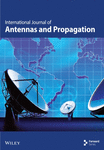Research on the Macrocell Wireless Channel Model Based on Physic-Inspired Support Vector Regression Algorithm Wireless Channel Model in Macrocell Environment
Abstract
To support wireless network planning and optimization in macrocellular environments, this paper presents an efficient machine learning method capable of achieving rapid predictive simulations at the kilometer level. The method embeds the building transmission model (BTM) into a machine learning framework based on support vector regression. The core of this new regression model lies in mapping the antenna and environmental feature information through the BTM into a high-dimensional space and then seeking the optimal hyperplane in this space that maximizes the margin with respect to the training data. In addition, a model was constructed and validated based on measured wireless channel data at frequencies of 900 and 3500 MHz. The results show that the root mean square error between the proposed model and the measured results is less than 7 dB, and the single-point simulation time of the proposed model for kilometer-scale large-scale coverage prediction is in the millisecond range.
1. Introduction
The efficient planning of macrocell [1] networks is considered to be a key cornerstone toward a green network [2–4], which requires accurate and reliable radio wave propagation modeling. For this task, researchers have developed many wireless channel prediction models for macrocells over the years. These models are generally divided into two categories: statistical models and deterministic models.
The statistical model [5–7] is developed by conducting extensive experimental measurements in different regions and utilizing statistical analysis to fit the propagation characteristics of other regions. Therefore, statistical models are simple and have fast computation speed, but their accuracy is not high [8, 9]. Different models should be studied for different scenarios, and the most similar model developed in a similar region should be used to achieve high accuracy [10, 11]. Deterministic models [12–14] rely on environmental features such as operating frequency, building type, obstructions, and precise geometric information of buildings, as well as material types of all measured areas [15, 16]. Such models use a large number of simulations to estimate the effects of scattering, refraction, and reflection on transmitted signals. Therefore, deterministic models are usually very complex, with slow computation speed, and the accuracy of computation is affected by the accuracy of environmental information [17–19]. In view of the limitations of both approaches, an increasing number of researchers have started to employ machine learning-based techniques [20, 21] for constructing wireless channel prediction models in macrocellular environments. The aim is to achieve computational efficiency, high prediction accuracy, and strong generality in electromagnetic wave propagation models.
1.1. Related Works
In reference [22], the optimal structure for artificial neural network-based wireless channel prediction model for urban environments was proposed, and their research results showed that as long as the size of the neural network is chosen correctly, the path loss model based on artificial neural networks can be effectively executed. In reference [23], the combination of image-based environmental representation methods and artificial neural networks can enhance path loss prediction in terms of accuracy and efficiency. In reference [24], a deep learning-based method was proposed to achieve accurate prediction of millimeter wave path loss. In reference [25], a general framework was proposed for training neural networks to predict path loss but without considering environmental information.
2. Challenges and Proposed Methods
- 1.
Currently, most studies use ray tracing as a reference, which may lead to inaccurate and impractical problems. Relying solely on ray tracing for comparisons cannot accurately measure acceptable coverage prediction accuracy. To the best of our knowledge, there has been no extensive drive test data work conducted in a large geographic area with multiple base stations that can serve as a reference for comparison to determine the actual results that have a significant impact on service provider plans.
- 2.
Most previous research has been entirely based on satellite maps, lacking support for universal data models such as triangulation networks. This limitation hinders the practical implementation of research findings.
- 3.
In the past, research in macrocellular environments has largely focused on extracting features based on scene and antenna information for direct use in machine learning training and prediction. However, these approaches often lack support from physical mechanisms, leading to poor model generalizability.
In order to address these limitations, this paper aims to explore and validate a macrocell wireless channel prediction model based on physically inspired support vector regression (SVR) algorithms. It is expected that the proposed model will significantly improve prediction accuracy, computational efficiency, and generality. The physical heuristic method combines a deep understanding of the physical characteristics of the channel to guide the construction and optimization of machine learning models. Insights gained from physical processes are used to effectively capture and utilize the nonlinear dynamic characteristics of the channel while also significantly reducing overfitting issues in data-driven methods, thereby improving the generalization ability and robustness of the prediction model.
In order to consider the impact of environmental geometric and electrical parameter information on radio wave propagation, this paper selects the building transmission model (BTM) [26] as an interpreter for the wireless radio wave propagation mechanism in macrocellular environments. BTM has been proven to be reliable [27–29]. In order to achieve the following goals: (1) better performance in handling noisy and anomalous data; (2) ability to handle complex nonlinear relationships; (3) fast training and prediction computation; and (4) easy integration with physical mechanisms. In the commonly used machine learning methods, this paper selects SVR [30] as the machine learning framework. SVR has its strong nonlinear modeling ability, robustness, ability to handle outliers, and effective generalization ability, which have made it widely used and recognized in practical applications [31–33].
- 1.
Embedding BTM into a machine learning framework based on SVR, the feature information of the antenna and environment is mapped into a high-dimensional space through BTM. In this space, an optimal hyperplane is sought to maximize the margin between the hyperplane and the training data, resulting in a new regression model referred to as BTM–SVR in this paper.
- 2.
Based on a comparative analysis with a large amount of measured data, this study systematically investigates the impact of attenuation coefficients and the number of support vectors on the accuracy, training time, and prediction time of BTM–SVR. The optimal attenuation coefficient and number of support vectors that balance accuracy and efficiency in macrocell environments are quantified.
- 3.
The combination of the BTM feature extraction algorithm for general scenarios and BTM–SVR has enabled the simulation of kilometer-level coverage prediction in macrocell environments. Based on the optimal attenuation coefficient and number of support vectors obtained, an efficient coverage prediction simulation model has been developed.
The remaining sections of this paper are organized as follows. Section 2 provides a detailed introduction to the theoretical approach and construction steps of BTM–SVR. In Section 3, the measurement activities are described and the measurement data is analyzed. The optimization and numerical analysis of BTM–SVR are presented in Section 4. Finally, conclusions are drawn in Section 5.
2.1. Propagation Model
The objective here is to integrate the wireless radio wave propagation mechanism into the SVR architecture within a macrocellular environment, with the aim of achieving efficient and rapid prediction of received power. This paper adopts BTM as a method for predicting wireless radio wave propagation in macrocellular environments. BTM is a semideterministic and semiempirical model that considers multiple influencing factors in the process of radio wave propagation while also being capable of rapidly solving these factors. Therefore, BTM is used as the sample mapping function for the kernel function in the SVR method, which satisfies the radio wave propagation mechanism in macrocell environments and achieves a fast computing speed.
2.1.1. The Theoretical Framework of BTM–SVR
In a macrocell environment, BTM is a radio wave propagation model that can better explain the main transmission mechanism. The model relies on prior knowledge of the exterior coordinates of the building, its dielectric constant, and a decay factor related to the overall field behavior within the building. The attenuation coefficient of a single building can be estimated by measuring the introduced attenuation of the propagating signal as it passes through the building. For real urban microcell scenarios, the method greatly enhances the efficiency of path loss prediction by taking into account the penetration and transmission of buildings.
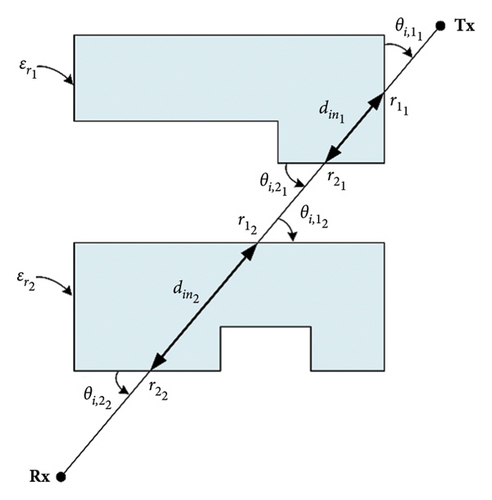
In the equation, Pt denotes the transmission power, Gt and Gr represent the antenna gains of Tx and Rx, c stands for the propagation speed of electromagnetic waves, f represents the frequency of the electromagnetic wave, and d signifies the distance between Tx and Rx.
2.1.2. Constructing BTM–SVR
-
Step 1: import Tx, Rx, and environmental data.
-
Step 2: rays are emitted from each Tx to each Rx, and feature information is extracted from the interaction between the rays and the environment to construct a sample set. In the subsequent research of this paper, 30% of the sample set will be randomly selected as the training sample set, with the remainder forming the test sample set.
-
Step 3: initialize the BTM–SVR parameter settings, set the maximum number of iterations n, and initialize the best predictive performance.
-
Step 4: if n > 0, proceed to Step 5; otherwise, terminate the execution.
-
Step 5: train the BTM–SVR by randomly selecting a corresponding number of samples from the training sample set based on the number of support vectors.
-
Step 6: predict the outcomes of the test sample set using the trained model. Compare these predictions with the actual measured results. If the expected predictive performance is achieved, terminate the process; otherwise, set n = n-1 and proceed to Step 4.
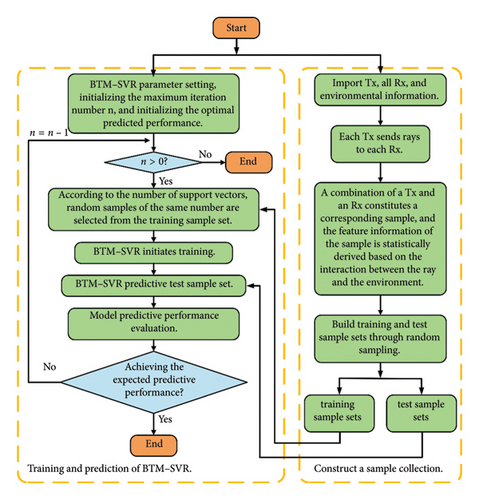
According to equation (5), the input sample features that need to be extracted from parameters of Tx, Rx, and environment are as follows: (1) the total number of buildings between Tx and Rx; (2) the sum of radio wave propagation paths within buildings between Tx and Rx; (3) the incident angles on surfaces of individual buildings; (4) the average permittivity of buildings between Tx and Rx; (5) the straight-line distance between Tx and Rx; (6) the radio wave frequency; (7) the tilt angle of Rx relative to Tx; (8) the power of Tx; and (9) the gains of both Tx and Rx. The output feature is received power.
From the construction steps, it can be observed that BTM–SVR possesses the following advantages: (1) BTM–SVR requires a small number of features that are easy to obtain and involves fewer matrix parameters, resulting in fast computation speed; (2) in comparison to typical machine learning methods, BTM–SVR does not necessitate data normalization; and (3) BTM–SVR is capable of predicting both path loss and received power.
2.1.3. Experimental Measurement Activity
The development of BTM–SVR proposed in this research is based on experimental data collected during measurement activities conducted in Zhengzhou City, China. The satellite map of the measurement area is shown in Figure 3, with a longitude range from 113°35′E to 113°45′E and a latitude range from 34°41′N to 34°52′N. The specific measurement groups are shown in Table 1. The electromagnetic wave frequencies measured were 900 MHz and 3500 MHz, and the method for measuring received signals was referenced from literature [34]. Both Tx and Rx utilize conical antennas of model PZ-100800/P, manufactured by Ainfoinc. These antennas cover a frequency range of 1–8 GHz and exhibit an omnidirectional radiation pattern within this broadband frequency range.
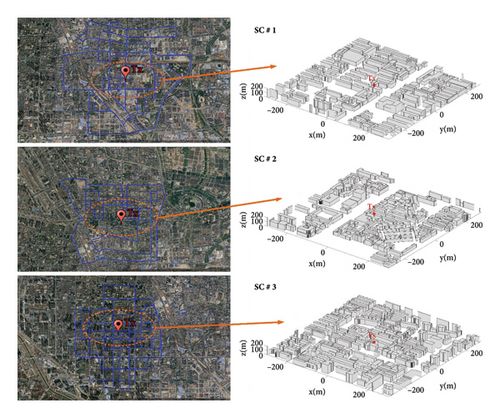
| Measurement groups | Environment | Frequency (MHz) |
|---|---|---|
| Mea 1 | SC # 1 | 900 |
| Mea 2 | 3500 | |
| Mea 3 | SC # 2 | 900 |
| Mea 4 | 3500 | |
| Mea 5 | SC # 3 | 900 |
| Mea 6 | 3500 | |
The measurement site comprehensively covers various typical environmental features in a macrocellular environment, with over 40,000 buildings including office buildings, residential communities, and shopping malls. As depicted in Figure 3, during the measurement activity, the Tx is placed at the designated position on the rooftop, while the Rx is positioned on top of the vehicle. The vehicle travels along the blue curve outlined in Figure 3. Receiver coordinates and received power are collected in real time as the vehicle moves. The measurement results are depicted in Figure 4. The minimum (MIN), maximum (MAX), average (AVG), and standard deviation (SD) of the measurement results under different conditions are presented in Table 2.
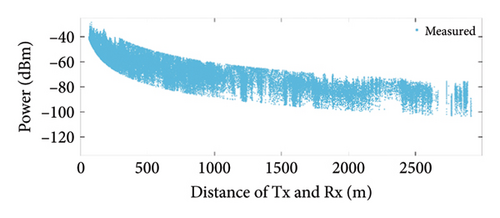
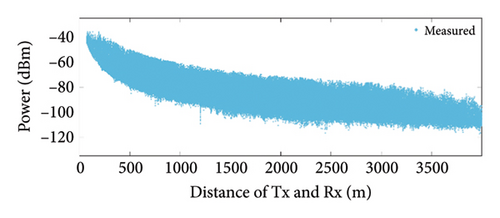
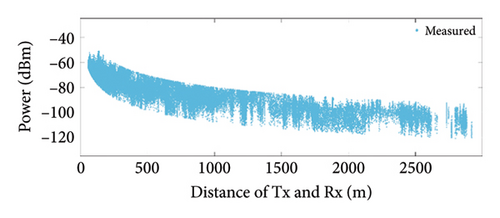
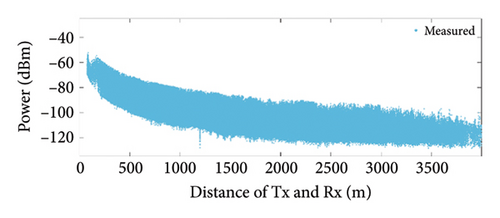
| Frequency (MHz) | LoS/NLoS | MIN (dBm) | MAX (dBm) | AVG (dBm) | SD (dBm) |
|---|---|---|---|---|---|
| 900 | LoS | −103.65 | −28.61 | −69.35 | 12.71 |
| NLoS | −119.32 | −36.00 | −87.58 | 11.72 | |
| 3500 | LoS | −120.70 | −51.17 | −86.75 | 12.90 |
| NLoS | −128.70 | −52.49 | −104.74 | 10.97 | |
From Figure 4 and Table 2, it can be observed that the average received power at 3500 MHz is lower compared with that at 900 MHz. This is due to the increase in propagation loss with frequency. In comparison to LoS, the average received power is lower in NLoS due to the longer propagation delay and energy loss during processes such as reflection and diffraction. The standard deviation of the measurement data under different frequencies and distances over a prolonged period remains stable at 10–13 dBm, indicating good stability of the measurement equipment for this test. In addition, the results also suggest that factors such as noise (moving individuals, vehicles, wind speed in the air, swaying trees, etc.) and equipment sensitivity in a macrocellular environment may have an impact ranging from −6 to 6 dBm.
2.2. Parameter Optimization and Numerical Analysis
According to the construction principle of BTM–SVR, the prediction efficiency and prediction accuracy of BTM–SVR are not only affected by the training samples but also mainly affected by αb and the number of support vectors. This section first studies the impact of αb on BTM–SVR and then studies the influence of the number of support vectors on BTM–SVR. Based on the comparative analysis with measurement results, the simulation of kilometer-level coverage prediction in macrocell is finally realized by combining the general scene BTM feature extraction algorithm and BTM–SVR.
2.2.1. Effect of αb on BTM–SVR
The number of support vectors is set to 200, with a maximum iteration count of 100. The expected performance is RMSE < 3, and the values of αb range from 0.001 to 1 in increments of 0.001. The simulation results are presented in Figure 5.
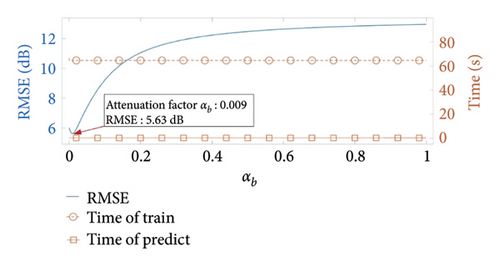
From Figure 5, it can be observed that when αb < 0.009, the prediction accuracy of BTM–SVR increases with the increase of αb. When αb = 0.009, the prediction accuracy of BTM–SVR reaches its peak, with an RMSE of 5.63 dB. However, when αb > 0.009, the prediction accuracy of BTM–SVR decreases as αb increases. This phenomenon can be attributed to the fact that the predicted received power by BTM decreases linearly with increasing αb, leading to corresponding changes in the “discrete process” of sample features mapped in a high-dimensional space by BTM. In addition, the variations in αb have no impact on the computational efficiency of BTM–SVR during both the training and prediction processes.
2.2.2. Effect of the Number of Support Vectors on BTM–SVR
Set the maximum iteration number to 100, with an expected performance of RMSE < 3. The value of αb is 0.009, and the support vector count ranges from 5 to 2000 in increments of 5. The results of the simulation are illustrated in Figure 6.
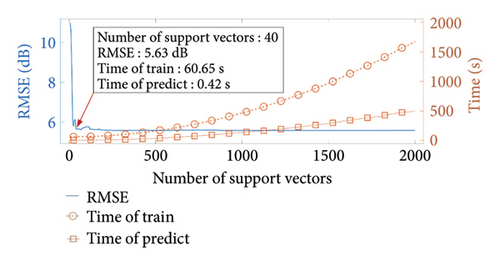
From Figure 6, it can be observed that when the number of support vectors is less than 40, the prediction accuracy of BTM–SVR increases with an increase in the number of support vectors. When the number of support vectors exceeds 40, BTM–SVR exhibits high prediction accuracy, with RMSE less than 6 dB and a tendency to stabilize. The training time and prediction time both increase with the increasing number of support vectors. This is due to the fact that the number of support vectors directly impacts the parameter count of BTM–SVR, including the size of matrices computed by the kernel function and the number of Lagrange multipliers. The increase in support vector count requires exponentially growing computational power.
2.2.3. Comparison and Analysis of Simulation Results With Measured Data
When αb = 0.009 and the number of support vectors is 40, the predicted results of BTM and BTM–SVR under various conditions are compared with the measured results, as illustrated in Figure 7. The specific simulation results and RMSE values from measurements are presented in Table 3.
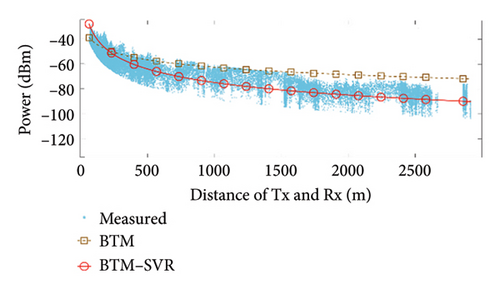

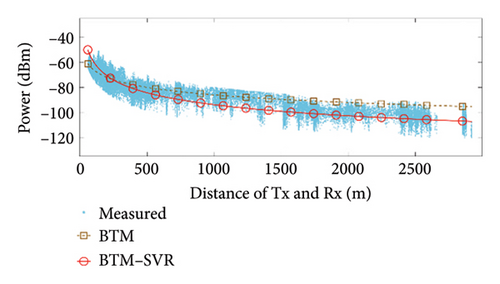
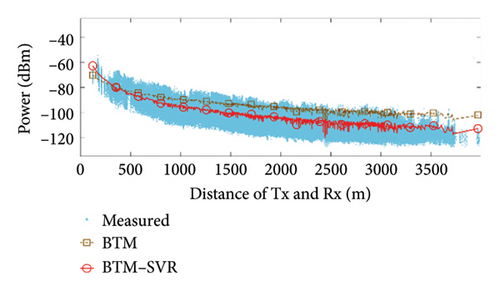
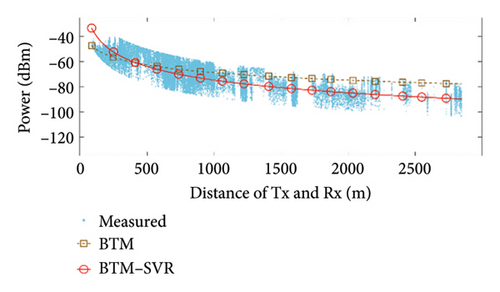
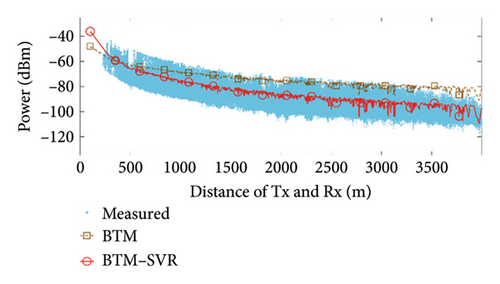
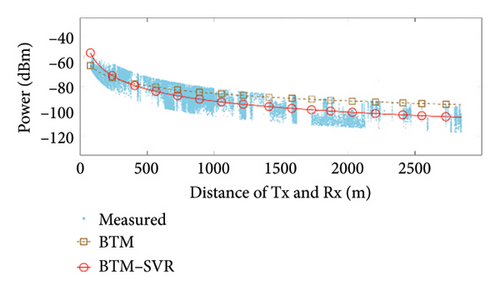
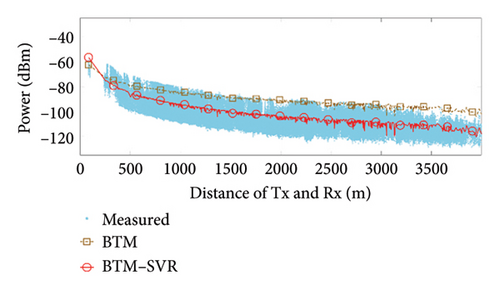
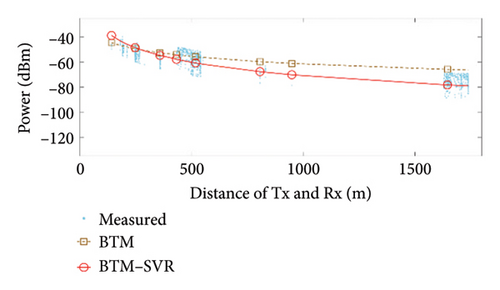
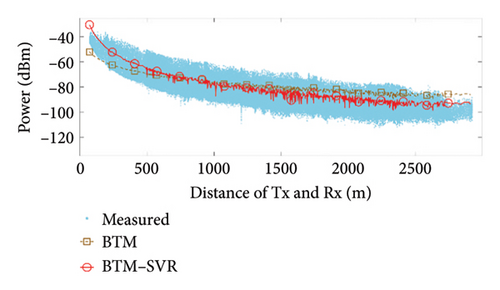
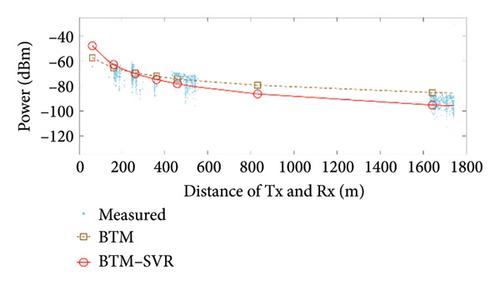
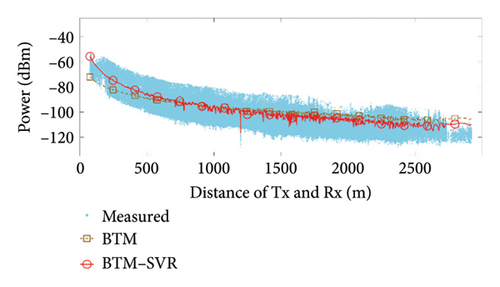
| Simulation scene | Frequency (MHz) | LoS/NLoS | BTM (dB) | BTM–SVR (dB) |
|---|---|---|---|---|
| SC # 1 | 900 | LoS | 11.65 | 6.13 |
| NLoS | 14.72 | 6.61 | ||
| 3500 | LoS | 7.73 | 5.85 | |
| NLoS | 12.34 | 6.26 | ||
| SC # 2 | 900 | LoS | 7.81 | 6.68 |
| NLoS | 15.16 | 6.83 | ||
| 3500 | LoS | 7.56 | 5.92 | |
| NLoS | 15.64 | 6.76 | ||
| SC # 3 | 900 | LoS | 7.35 | 5.83 |
| NLoS | 9.43 | 6.98 | ||
| 3500 | LoS | 7.04 | 5.68 | |
| NLoS | 8.72 | 7.04 | ||
From the results shown in Figure 7 and Table 3, it can be seen that compared with BTM, the RMSE in the LoS condition at 900 MHz frequency was improved by 5.52 dB, 1.13 dB, and 1.52 dB in the three scenarios, respectively. The RMSE in the NLoS condition was improved by 8.11 dB, 8.33 dB, and 2.45 dB in the three scenarios, respectively. At 3500 MHz frequency, the RMSE in the LoS condition was improved by 1.88 dB, 1.64 dB, and 1.36 dB in the three scenarios, respectively. The RMSE in the NLoS condition was improved by 6.08 dB, 8.88 dB, and 1.68 dB in the three scenarios, respectively. Clearly, BTM–SVR addresses the issue of decreasing prediction accuracy in BTM as distance and the number of buildings passed increase. In various frequencies and scenarios, BTM–SVR outperforms BTM in both LoS and NLoS conditions, with a particularly notable improvement under NLoS conditions. The prediction accuracy of BTM–SVR is approximately 6.5 dBm, which closely aligns with the measured results.
2.2.4. Prediction of Coverage Area
In network planning and optimization, it is often necessary to make predictions about regional coverage. BTM–SVR is capable of computing the received power by utilizing the extracted BTM feature information. Therefore, integrating the algorithm for extracting BTM feature information with BTM–SVR enables the construction of a coverage prediction simulation for macrocell. When αb = 0.009 and the number of support vectors is 40, with a simulation granularity of 10 m, the coverage prediction results of BTM–SVR under different conditions are shown in Figure 8. The statistical results of the simulation calculations on the laptop with a CPU of i7-13700H are presented in Table 4.
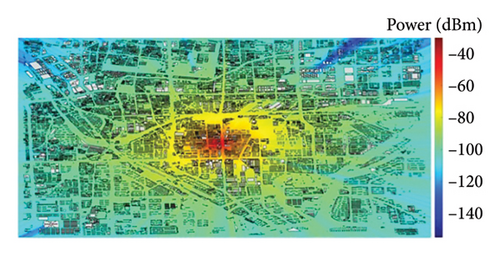
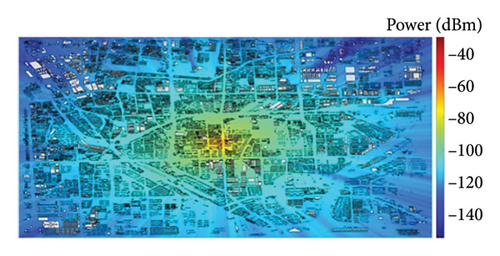
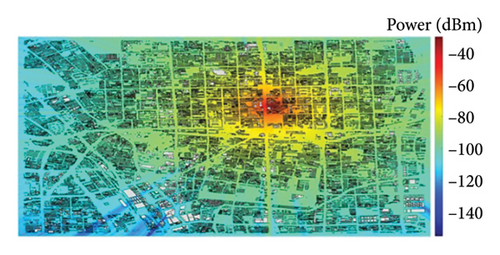
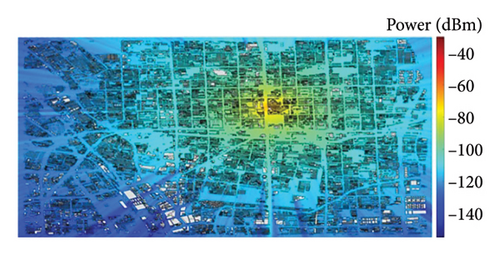
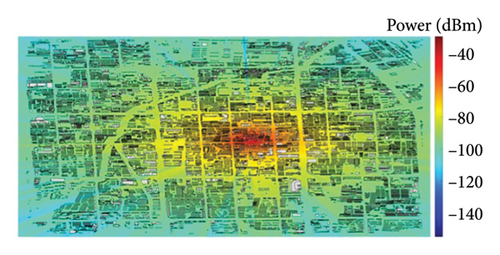
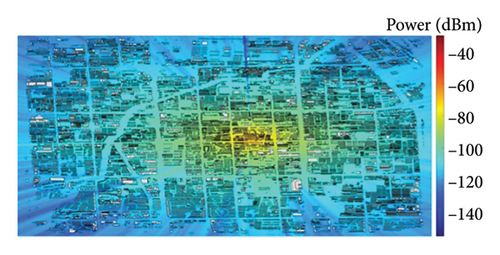
| Simulation conditions | The number of buildings | Simulation scene dimensions (m) | Number of receivers | Simulation time-consuming (s) | Average computation time for Rx (ms) |
|---|---|---|---|---|---|
| (a) SC # 1, 900 MHz | 15,464 | 6401∗6198 | 417,852 | 3729 | 8.92 |
| (b) SC # 1, 3500 MHz | 3843 | 9.20 | |||
| (c) SC # 2, 900 MHz | 17,501 | 6159∗5476 | 356,448 | 3361 | 9.43 |
| (d) SC # 2, 3500 MHz | 3482 | 9.77 | |||
| (e) SC # 3, 900 MHz | 10,815 | 4057∗5348 | 232,522 | 1565 | 6.73 |
| (f) SC # 3, 3500 MHz | 1685 | 7.25 | |||
From Figure 8 and Table 4, it is evident that BTM–SVR supports kilometer-level surface coverage prediction, with the average computation time for individual receiver predictions being only a few milliseconds. Compared with 3500 MHz, the effective radiation range of 900 MHz is broader in scope. The greater the number of buildings within the coverage area, the lower the calculation efficiency, due to the decreased computational efficiency in feature extraction by BTM. Furthermore, the coverage prediction map computed by BTM–SVR shows clear linear stripes, which is due to the fact that BTM only considers the influence of electromagnetic waves on the Tx and Rx located on a straight line.
3. Conclusions
This paper proposes a machine learning method, BTM–SVR, for predicting wireless channels. The kernel function of BTM–SVR is inspired by BTM and is suitable for wireless channel prediction in macrocellular environments. Compared with the measured results, the RMSE of BTM–SVR at 900 MHz frequency in the LoS condition in the three scenes was 6.13 dB, 6.68 dB, and 5.83 dB, respectively. The RMSE in the NLoS condition was 6.61 dB, 6.83 dB, and 6.98 dB, respectively. At 3500 MHz frequency, the RMSE in the LoS condition in the three scenes was 5.85 dB, 5.92 dB, and 5.68 dB, respectively. The RMSE in the NLoS condition was 6.26 dB, 6.76 dB, and 7.04 dB, respectively. In addition, BTM–SVR exhibits highly efficient training and prediction speeds, making it well suited for large-scale coverage prediction simulations. This capability can significantly aid in network planning and optimization decision-making within macrocell environments.
Looking ahead, as the coverage area and distance increase, further measurements will be needed to systematically verify and enhance the model’s prediction accuracy. Meanwhile, to improve the applicability of our model, we plan to conduct further research and validation by fully considering diffraction and scattering factors in different urban environments in the future.
Conflicts of Interest
The authors declare no conflicts of interest.
Funding
This work was supported in part by the National Key Laboratory Fund of Electromagnetic Environment (Grant no. JCKY2024210C61424030301), the key project of Social Governance and Scientific and Technological Support for Smart Society (Grant no. 2022YFC3301403), and the Foundation of China Information Technology Designing & Consulting Institute Co. Ltd.
Acknowledgments
This work was supported in part by the National Key Laboratory Fund of Electromagnetic Environment (Grant no. JCKY2024210C61424030301), the key project of Social Governance and Scientific and Technological Support for Smart Society (Grant no. 2022YFC3301403), and the Foundation of China Information Technology Designing & Consulting Institute Co. Ltd.
Open Research
Data Availability Statement
The data used to support the findings of this study are available from the corresponding author upon reasonable request.



